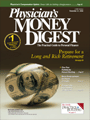Close-Up: Dividends
Presented McNeil, by Makers of Tylenol
n.
Dividend: A sum of money paid to stock shareholders of a corporation as a result of earnings.
Money
For several decades, the rule of thumb forbuilding wealth through investing was tobuy and hold growth stocks. As a recent articlein explains, you stake your financialfuture on the share of companies that increasetheir earnings by more than 12% year after year. Buttimes change and rules are meant to be broken. As thearticle professes, the market is in the early stages of afundamental shift that will increase the value of dividend-paying stocks, reinstating them as the vehicle ofchoice for most physician-investors.
Think of dividends as a small reward paid to youby a company for owning shares of its stock. Nowconsider that the dividend tax rate has been slashed inrecent years and now stands at 15%. According tothe article, that means that investors will now be ableto keep $0.85 per dollar of payout compared withjust $0.51 back in 1980. In effect, the lower tax rateshave negated much of the advantage that growthstocks had over dividend-paying stocks.
What Was Old Is Now New
Money
As the article explains, companies essentiallyhave two options for how they can utilizemonies that remain after subtracting the cost of businessoperations. They can either reinvest it or theycan distribute it to shareholders in the form of dividends.By investing in profitable enterprises, earningsshould rise, followed by the company's share price.And shareholders avoid paying capital gains tax onthe earnings that companies reinvest.
The problem today is that the opportunities toprofitably reinvest earnings have dried up. Accordingto the article, companies often end up investing in lessprofitable businesses, making acquisitions that oftenfail or allowing the money to earn low rates of interest.None of these is a viable option. So it came as nogreat surprise this past July that Microsoft intendedto pay a $32-billion special dividend and double itsregular dividend. Not coincidentally, the articlereports that 170 companies have declared dividendsthis year for the first time.
The return of dividends to prominence benefitsboth shareholders and companies. Shareholdersreceive an anticipated return that they can use to purchasemore shares or reinvest elsewhere. Companies,in turn, are able to keep their resources focused ontheir most profitable operations.
Is Change Here to Stay?
Another indicator of this shift is that dividends paidby the S&P 500 are projected to increase nearly 14%this year, boosting the yield of stocks in the index to1.8%. As dividends increase in value, companies aresimilarly raising the amount of their payouts as a way toattract potential shareholders. In addition, the price ofdividend-paying stocks has begun to rise.
Money
According to the article, stocks in the S&P500 that pay dividends have outperformed nonpayersby 11.4% this year. The difference in price-to-earningsratios between growth stocks and blue chips hasdropped to about half of what it was 4 years ago.And as more investors embrace dividend-payingstocks, that gap could narrow further.
The question is, will this trend continue?According to the article, the law cutting taxes on dividendsis scheduled to come up for renewal in 2008.However, the article also points out that eliminatinghigh taxes on dividends is a net plus for the economy.As such, some form of dividend tax relief is likely toremain in effect.
For now, dividend-paying stocks appear to beback in vogue, thanks in large part to lower tax rates.And, as the article notes, on a level playing field,stocks that yield 2% to 4% a year in dividends shouldoutperform the more glamorous growth stocks bydelivering equal or better returns with greater predictabilityand lower risk.
Select a Good Dividend-Paying Stock
If you're looking to adjust your investment portfolioand purchase some dividend-paying stocks,there are some key criteria to consider.
Money
According to an article in , start by lookingfor large companies that have strong balance sheets.These companies should yield between 2% and 4%,while offering an annual growth rate of at least 9%.In addition, the best of these companies will trade atprice-to-earnings (P/E) ratios of less than 20 timestheir estimated 2005 earnings.
To get you started, the article pinpoints severalstocks that meet the criteria, including the following:
• Abbott Laboratories—The pharmaceuticalmanufacturer reported a second-quarter earningsgain of 14%. Its P/E ratio is 15.4, and current dividendyield is 2.7%. In addition, eight of its majordrugs are growing at double-digit rates.
• Citigroup—The financial services company hadprofits that were up 24% in the second quarter. Thecurrent dividend yield is 3.6% and the P/E ratio is 10.The red flag here is that a quick rise in interest ratescould hurt the company.
• DuPont—The nation's largest chemical companyis in the midst of restructuring, but its core growth rateover the next 5 years is still expected to average 10%.Its current dividend yield is 3.3%, and P/E ratio is 15.6.
Pop Quiz
1) The main reason for the increased attractiveness ofdividend-paying stocks is:
- Low dividend tax rate
- Increased profitability
- Lower price-to-earnings ratio
- Company generosity
2) The number of companies declaring first-time dividendsthis year is:
- 150
- 160
- 170
- 200
3) The return to prominence of dividend-payingstocks benefits:
- Shareholders
- Companies
- Both shareholders and companies
- None of the above
4) The dividend-paying stocks in the S&P 500 haveoutperformed the nonpaying stocks this year.True or false?
- True
- False
5) The criteria for purchasing a profitable dividend-payingstock include:
- Yield between 2% and 4%
- Annual growth rate of at least 9%
- Strong balance sheet
- All of the above
Answers: 1) a; 2) c; 3)c; 4) a; 5) d.
